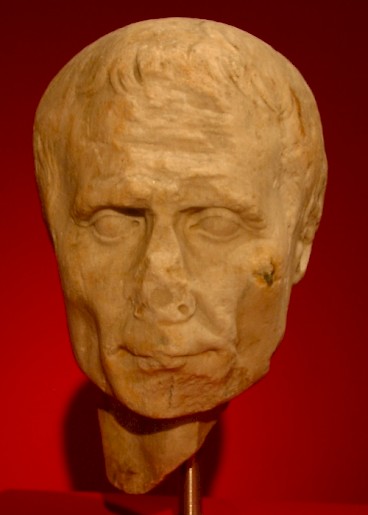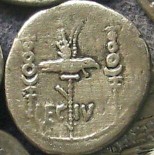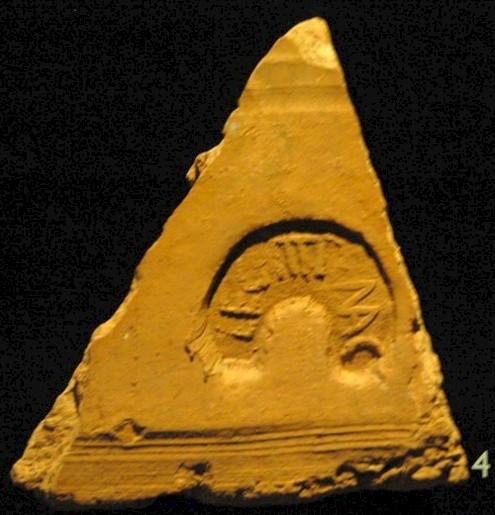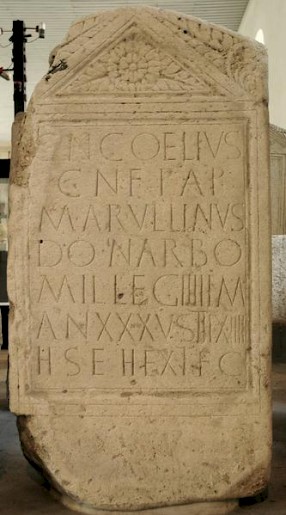Legio IIII Macedonica
Legio IIII Macedonica: one of the Roman legions. Its name means "the legion from Macedonia".

This legion was probably founded in Italy in 48 BCE by Julius Caesar, who needed it in his war against his fellow-triumvir and rival Pompey the Great. It saw its first action at Dyrrhachium (Spring 48). Later, it was stationed in Macedonia. The unit was earmarked for Caesar's campaign against the Parthian empire, but the expedition was canceled after the dictator's death. In the summer of 44, the Fourth was recalled to Italy by Mark Antony and was active in eastern Italy, but not much later, it sided with Caesar's adopted son Octavian. In the battle of Modena in April 43, it fought for its new commander against Antony and suffered heavy losses.
In 42, it fought for the members of the Second Triumvirate in the battle of Philippi in Macedonia (where they defeated Caesar's assassins, Brutus and Cassius) and returned to the Italy with Octavian, where it fought in the Perusian war against Mark Antony's brother Lucius. Sling bullets attest to its presence during the siege of Perugia.
In 31, it was present at the naval battle off Actium. Veterans were settled in the Veneto.
Octavian, now called Augustus, stationed this legion in Hispania Tarraconensis after 30 BCE, where it took part in his campaigns against the Cantabrians, which lasted from 25-13 BCE. Apart from IIII Macedonica, I Germanica, II Augusta, V Alaudae, VI Victrix, VIIII Hispana, X Gemina, XX Valeria Victrix, and perhaps VIII Augusta were involved. The Fourth was based at Herrera de Pisuerga. It has been proposed that some veterans were settled in a town that is now called Cuartango (from quattuor, "four").

After 13 BCE, Hispania became more tranquil. That the soldiers were active as civil servants all over the Iberian peninsula, can be deduced from inscriptions that were found as far south as Andalusia.
It was probably the emperor Claudius who transferred the Fourth Macedonian legion to Mainz in Germania Superior, probably in 41 (or 43?). Here, it replaced XIV Gemina, which was now fighting in Britain. However, it is also possible that the transfer took place in 39, when Caligula waged war against the Germanic Chatti. Anyhow, the Fourth shared the fortress with the recently founded XXII Primigenia. The younger unit occupied the less honorable left-hand side, whereas IIII Macedonica was living in the right-hand side.
It was still at Mainz when Claudius' successor Nero committed suicide (June 68) and civil war broke out (January 69). The Fourth legion and the Twenty-Second were the first to side with Vitellius and a large, mixed subunit took part in Vitellius' march to Italy. It conquered the road through Switzerland, fought at Cremona against the troops of the emperor Otho - parts of one of its catapults have been found - and finally reached Rome. Several soldiers were rewarded for their service and transferred to the imperial guard.

Meanwhile, in Germania Inferior, a disaster was in the making. The Batavians felt offended because Galba had dismissed his Batavian bodyguard, and revolted. A Roman expeditionary force, consisting of the remains of V Alaudae and XV Primigenia, was defeated near Nijmegen, and not much later, these two legions found themselves besieged at Xanten. Although I Germanica, XVI Gallica and the other legion from Mainz, XXII Primigenia, tried to rescue them, the two legions at Xanten were forced to surrender in March 70. Not much later, I Germanica and XVI Gallica surrendered as well.
It took several months before the new emperor Vespasian could send a strong Roman army to recover the Rhineland and suppress the Batavian revolt, commanded by his relative Quintus Petillius Cerialis. The legions V Alaudae and XV Primigenia were never reconstituted; the remains of I Germanica were added with Galba's Seventh legion and became known as VII Gemina ("the twin legion"); XVI Gallica was renamed (XVI Flavia Firma).

During these troubles, IIII Macedonica had guarded Mainz against attacks by Germanic Chatti, Usipetes and Mattiaci. Although it had for some time been successful and fought bravely during Cerialis' campaign, it was guarded with some suspicion by the new emperor. This explains why it was punished as well: it was reconstituted under a new name, IIII Flavia Felix.
Like almost all Caesarian legions, the emblem of IIII Macedonica was a bull. It also carried the capricorn.
Literature
- D. Baatz, "Ein Katapult der legio IV Macedonia aus Cremona" in: Mitteilungen des deutschen archäologischen Institut Röm. Abt.) 87 (1980) 283-299
- J. Gómez-Pantoja, "Legio IIII Macedonica", in: Yann Le Bohec, Les légions de Rome sous le Haut-Empire (2000 Lyon) 105-117
- A. Morillo Cerdán, "La legio IIII Macedonica en la península Ibérica. El campamento de Herrera de Pisuerga (Palencia)", in: Yann Le Bohec, Les légions de Rome sous le Haut-Empire (2000 Lyon) 609-624